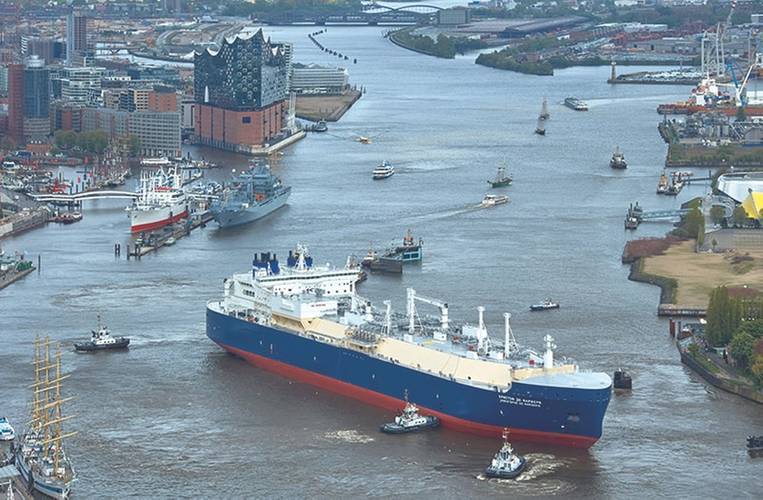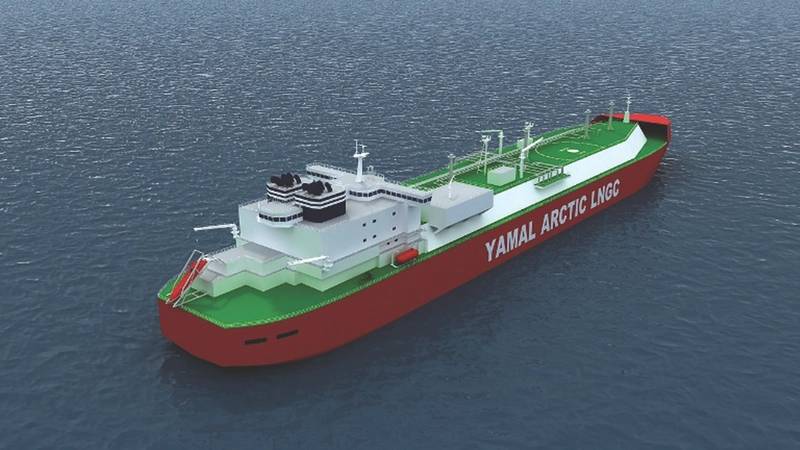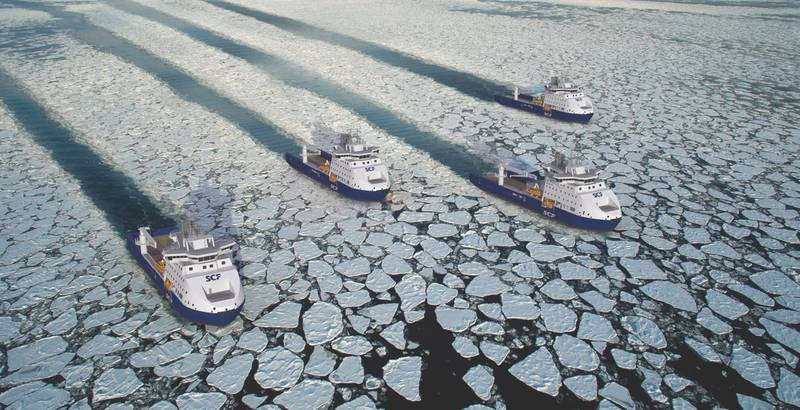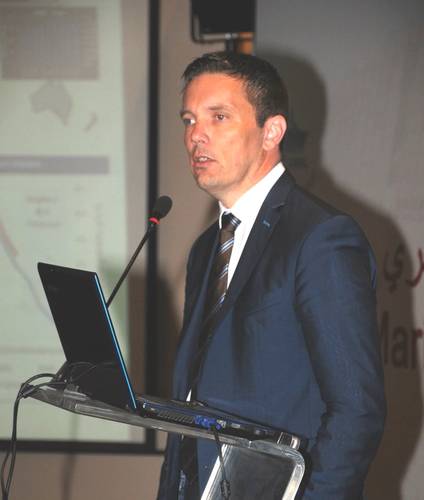The Woodmac report we saw offered us cause for pause — “Strong activity from the (major oil companies)” while “national oil companies have tightened their purse strings.” What Maritime Reporter found, was that national oil companies — nation-builders, for many — are putting their money in affiliate shipyards. The hope of two, new shipbuilding giants is jobs, innovation, national survival and export security. The model is to invite those who have done it before: Koreans, Japanese, French and a contractor with offshore and marine experience.
Competition, too, may be providing impetus for giant shipyard schemes at Ras El-Khair in Saudi Arabia and at Sabetta and Bolshoi Kamen in the Russian Far North and Far East. For Saudi, rival Qatar’s shipyards produce large and small vessels, and its fleet of LNG carriers is large and emboldened by a new deal with Hoegh LNG to explore FSRUs. For Russia, there’s the crush of destabilized oil prices.
At Ras El-Khair, a Saudi Aramco joint venture will produce jack-up rigs, offshore service vessels (OSV) and very large crude carriers (VLCC). At Sabetta on the Arctic Kara Sea and at Bolshoi Kamen on Russia’s Pacific Coast, ice-breaking vessels, offshore structures, VLCCs and gas carriers. Russia’s aim is to offer the world’s first, arctic-only offshore fleet to complement its ice-breaking tankers and the Christophe de Margerie, St. Petersburg-based SCF’s Korean-built ice-breaking LNG carrier. As with Saudi Aramco, energy giants Rosneft and Novatek are backing the Russian mega yards.
Global Impact
Whatever the mega yards’ sprawl in square miles, their eventual impact on the market for smaller vessels is in doubt. “Big yards can build small ships effectively, too, if the number of vessels is high,” said Cankut Demirkol, business development manager at Turkey’s Özata Shipyard. “You can effectively build small tugs, ferries, trawlers, etcetera, if they are a series of vessels (otherwise) … the income from the vessel will not cover the expenses.”
Apart from planned capacity for four rig builds and three VLCCs a year, some 40 other shipbuilding slots for unspecified vessel types will shape the Saudi yard. Its joint venture between Saudi Aramco, Lamprell and Hyundai Heavy Industries will use facilities built by U.S.-based marine contractor, McDermott International. It is understood that McDermott will engineer the Saudi yard and HHI the VLCCs. Mr. Demirkol sees transfers of Korean crews to El Khair. “It’s wiser,” he says.
In Russia, Daewoo is overseeing much of the work on yard facilities at the Zvezda shipbuilding complex in cooperation with Russian SCF, while a Zvezda-Hyundai JV formed in 2017 will focus on the shipbuilding. The orders have swelled Korean yard orderbooks, with HHI’s up 150 percent since Vladimir Putin’s 2016 visit to Seoul. Though their impact on markets for smaller vessels is in doubt, the impact of Korean knowhow in Saudi and Russia will be felt. “It will be an addition to current shipbuilding overcapacity and as such contribute to a pattern of continued short earnings cycles in shipping,” says Dag Kilen, senior shipping analyst at Fearnley Consultants in Oslo. He says it piles pressure on yards everywhere. “As HHI is known to be an outstanding Tier I yard group — and quality never goes out of fashion — Tier II yards should fear this addition,” Mr. Kilen says about El Khair.
Saudi JVs
At Khair, the building of jack-up rigs in a depressed offshore drilling market looks set to kick-off by 2019, headed by jack-up builder Lamprell.
For Lamprell, working now from three smaller UAE yards, a JV at the biggest shipyard in the Middle East means “two rigs a year” plus non-rig marine maintenance. Lamprell will invest $140 million to earn 20 percent of the shipyard JV. Saudi Aramco will invest $350 million for 50.1 percent, and the Kingdom will inject $3.5 billion.
Rowan Companies chief exec, Tom Burke — part of a separate Aramco JV— declared a “growing Saudi Arabian offshore drilling market” was at hand, and that “rig commitments” for Rowan jack-ups were now long-term. Rowan will contribute three jack-ups to the rig JV, Saudi Aramco two.
Heikkinen Energy Advisors offshore analyst, David Smith, says the Saudi plan is “more about job creation” and not “Aramco’s view of global jack-up market fundamentals in ’20 and beyond.” He points to jack-ups sold recently for $65 million, or over 60 percent less than original price. “If Aramco were only concerned about a future shortage of jack-ups, it would be much cheaper to buy their own fleet than to build it,” Mr. Smith says. Heikkinen forecasts 365 jack-ups under contract in 2020, or 20-percent more than today. “But it’s far below the current marketed supply of 461 rigs, not to mention the 98 jack-ups under construction.”
Key Knowhow
McDermott will build the marine complex that’ll be the JV’s heart and will move to Khair from nearby Dubai for a long-term land lease from where it’ll provide training.
For “the next 50 years,” chief exec David Dickson sees McDermott expanding its offshore and subsea capacity at Al Khair to serve subsea markets from East Africa to the India. “The future fabrication is expected to provide up to 16 million manhours of capacity, up from eight million manhours” at McDermott’s Jebel Ali facilities. Mr. Dickson says he supports the Saudis’ Vision 2030 and Saudi Aramco’s In-Kingdom Total Value Add program, or IKTVA, aimed at 51-percent local content by 2021.
Hyundai at Khair won’t be limited to big builds and will sell 2-stroke and 4-stroke engines and pumps with on-site manufacturing. “Very large and small vessels” are to be served, Aramco says. “The new JV will also operate under a MAN-HHI sublicense for the manufacturing and servicing of 2-stroke engines.”
Shipping Circles
Bahri, the largest VLCC owner in the world, will pay $139 million for 20 percent of the shipyard JV. VLCC builder, Hyandai, will front $70 million for 10 percent. Mr. McDonald, now Lamprell’s outgoing chief exec, estimates Bahri will buy three-quarters of its oceangoing vessels from the JV over 10 years, or no less than 50 vessels, many of them VLCCs.
Some serious observers say the world has enough shipyard capacity already. “The ample, available existing capacity has, post the financial crisis, created short earnings cycles for shipping, as the supply side of the shipping market can respond quickly to any demand improvements,” says Mr. Kilen, a tanker expert. He says the overcapacity pattern has recently been seen in most shipping segments. Dry cargo, for one, has made three “recovery attempts” since 2009, and the first two, he says, were killed “by massive newbuild contracting and deliveries once demand improved.
“The results of the third ongoing attempt remain to be seen. LNG and LPG shipping both had their brief periods with strong earnings a couple of years ago, but here, too, the high contracting activity and newbuilding deliveries that followed took the market quickly back down to earnings that barely covered operations. Lately, the tanker market has started to suffer the same.”
Russia Builds
Like the Saudis, the Russians are undeterred. In 2016, they began in earnest a campaign to secure supplier help for a mega shipbuilding program announced in 2015. Early on, China’s Nantong COSCO agreed a deal to deliver four cranes to the shipbuilding complex at Bolshoi Kamen. Chinese heavy dockyard transporters were thrown into the deal. Like Aramco, it’s oil major Rosneft penning deals to help naval repair yard Zvezda go commercial, with Novatek doing the same for Sabetta to built a sea port, airport and fabrication facilities. A steel-smelting JV involving RM Steel was formed especially for Zvezda, which is gearing up for its first ship orders — five 114,000 dwt, LNG-fuelled Aframaxes, and four Icebreaker 7 OSVs — to be built be built by FESRC (the Zvezda-Hyundai JV). The Aframaxes are for the HHI-design behind Shell and SCF’ de Margerie.
Like the Saudis, the Russians have brought in the Koreans. In June 2017, France’s GTT signed an MoU to develop membrane containment systems for LNG vessels to be built at Zvezda for Yamal LNG’s Sabetta port, where Novatek has been trying to play the role of Rosneft and Aramco by allotting USD400 million in LNG fabrication capacity.
Arctic JVs
Zvezda Shipbuilding Complex will likely become the largest shipyard in Russia for the $4.5 billion being spent on commercial production facilities and infrastructure. Modern steel-cutting robotics are set to assist “automated lines and standard jigs and fixtures”, as they build tankers of up to 350,000 dwt; LNG carriers of 250,000 cu. m. ice class OSVs and transports of up to 29,000 dwt. Phase 1 — keel-laying blocks, workshops, a coatings JV with ChemChina — sets the stage for two drydock builds and thousands of jobs. German IMG and Daewoo Shipbuilding & Marine are understood to be hired to make all go smoothly at Zvezda’s Far Eastern Shipbuilding and Ship Repair Center, or FESRC. Also on-hand is an arctic drill-rig business of Zvezda, Keppel and MH Wirth called Antares.
A loose agreement with Italian Fincantieri to study new ship designs has also been arranged by Rosneft for Zvezda. Ice-breaking LNG shuttle tankers might be that agreement’s pretext, as France’s GTT has agreed to “(design and manufacture) cargo containment systems for LNG vessels” built by Zvezda but needed offshore at Sabetta. At it for 50 years, GTT tech is in everyone’s LNG offering — everyone’s.
Whatever the progress of the assembled expertise, Zvezda will have to ready — Order No. 1, a Rosneft Aframax of 114,000 dwt, is due for delivery in 2019, or when the mega yards really take off. By then, the tanker market might have changed again.
“My forecast … is a stronger tanker market,” says Mr. Kilen. “The current down-cycle for earnings I expect will last until late 2018, before a stronger earnings cycle is experienced during the 2019-2021 period.” A key driver of those stronger earnings is expected to be fewer newbuilding deliveries and a phase-out of older vessels due to the sulfur cap.




















